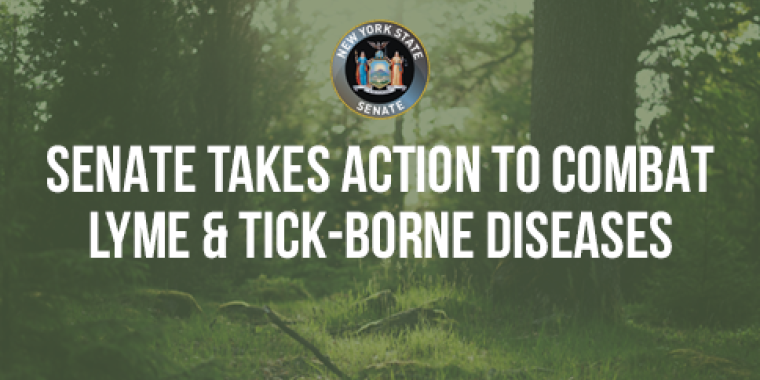
Action Taken to Address Lyme and Tick-Borne Disease Crisis
Catharine Young
June 24, 2015
-
ISSUE:
- Agriculture
- Education
- Environment
- Finance
- Health

Focus is on improving prevention, diagnosis, and treatment of tick-borne diseases
ALBANY – Improvements to the methods of preventing, diagnosing, and treating Lyme and other tick-borne diseases, along with legislation to help stop the spread of the deer tick population, recently passed the state Senate.
The legislative package was the result of work done by the Senate’s Task Force on Lyme and Tick-Borne Diseases, to which Senator Catharine Young (R,C,I- Olean) was appointed earlier this year, and is aimed at addressing the rising public health crisis.
“In recent years, the tick population and the diseases they transmit have become an issue of tremendous concern across the state. Lyme and other tick-borne diseases pose a serious health threat to people and pets, and complications from the diseases can have devastating long-term consequences. With these concerns in mind, my colleagues and I set forth to conduct hearings, meet with patients affected by the diseases, and solicit advice from medical professionals about how to best combat the growing crisis,” said Senator Young.
Senate bill 5802 helps homeowners protect their properties from ticks by requiring the Department of Environmental Conservation (DEC) to develop guidelines for treatment of residential properties based on integrated pest management.
Senate bill 5803 authorizes the Department of Health (DOH) to design a Lyme and tick-borne disease prevention program, which would include information on how to safely use insect repellents, strategies for tick removal, recommendations for reducing exposure to ticks, and an appropriate course of action for once a tick has been removed.
Senate bill 5804 directs the state Department of Education (SED) and DOH to work together to develop instructional materials on tick-borne infections for children. Age-appropriate materials would be produced, incorporating visual guides and other information to teach children protections from ticks, and how to identify and react to a tick bite.
“Knowledge is power. Having the state produce informative materials that help homeowners, outdoorsmen, and parents keep themselves, and the ones they love, safe will be another positive step in addressing the Lyme crisis. Lyme and other tick-borne diseases aren’t spread like traditional health problems, such as the common cold, and our approach to combating them needs to be multi-faceted if we want to bring the problem under control,” Senator Young continued.
Earlier this year, Senator Young and her colleagues secured an unprecedented $600,000 in the 2015-16 State Budget to combat the spread of Lyme and other tick-borne illnesses. The Senate’s Task Force on Lyme and Tick-Borne Diseases is also preparing to launch a new comprehensive website with important tools and resources for those battling the illness or looking to protect their families.
Roundtable forums to gain information from Lyme disease patients, medical experts and health officials will be scheduled around the state later this year to gather more information to develop additional policy.
Share this Article or Press Release
Newsroom
Go to NewsroomStatement from NYS Senator Catharine M. Young (R,C,I-57th District)
February 28, 2019
Town of Mansfield Slated to Receive $300,000 State Grant
February 27, 2019

Senator Young Secures $125,000 for Town of Ripley
February 27, 2019

